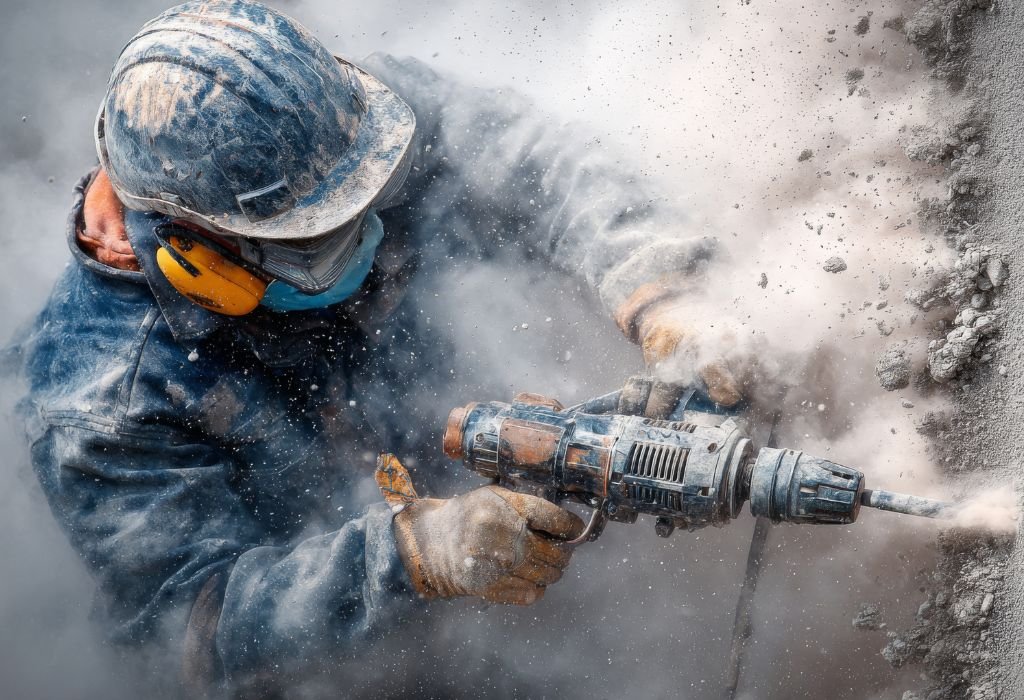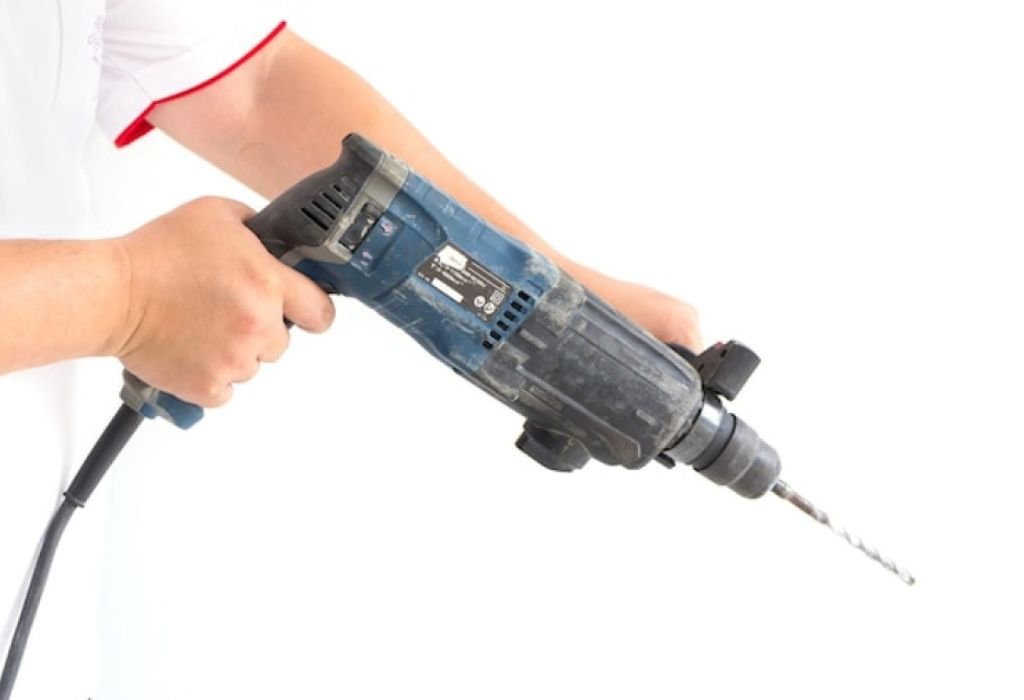Imagine trying to drill a hole in solid concrete with a regular power drill. The bit overheats, progress slows to a halt, and frustration sets in quickly.
This is where the rotary hammer drill proves its worth.
Designed for heavy-duty tasks, it combines rotation with powerful hammering force to break through masonry, stone, and concrete.
Many people confuse rotary hammers with standard hammer drills, but they are not the same.
A rotary hammer uses a piston-driven mechanism that delivers far greater impact energy.
The question what is a rotary hammer drill often arises when projects demand more power than a typical drill can provide.
Understanding the answer ensures the right tool is chosen for the right job.
From construction sites to home renovations, these tools are essential for anchoring, chiseling, and demolition tasks.
Without them, tackling tough materials becomes almost impossible.
According to Grand View Research, the global power tools market surpassed $36 billion in 2022 and continues to grow (source).
Rotary hammers hold a strong share because of their unmatched efficiency in masonry work.
Choosing the right rotary hammer drill means balancing features like SDS systems, impact energy, and weight.
It also requires knowing when this tool is necessary and when a lighter drill will suffice.
This guide explains everything in detail, from how they work to the best applications.
By the end, readers will know exactly why rotary hammer drills stand out and how to use tQuick Answer: What Is a Rotary Hammer Drill?
A rotary hammer drill is a power tool designed for heavy-duty drilling and chiseling in masonry, stone, and concrete. It combines rotation with a piston-driven hammering mechanism to deliver high impact force.
Unlike a standard hammer drill that uses a cam action, a rotary hammer produces much stronger blows. This makes it ideal for tasks where a normal drill would struggle or fail.
Q&A Section
Is a rotary hammer drill the same as a hammer drill?
No, a rotary hammer is more powerful, using a piston system instead of simple vibration.
What is a rotary hammer drill used for?
It is mainly used for drilling into concrete, stone, brick, and for light demolition.
Can it be used on wood or metal?
Yes, but only in drilling mode with the right bits. It is not recommended as the main tool for wood or metal projects.
Do rotary hammers need special bits?
Yes, they require SDS or SDS-Plus/SDS-Max bits designed for the locking system.
Are they only for professionals?
No, compact rotary hammers are also available for DIY use.
How Rotary Hammer Drills Work

The rotary hammer works with a piston-driven mechanism that compresses air and drives the bit forward with each stroke. This design delivers far more impact energy compared to a hammer drill.
The bit is held in an SDS chuck, which locks securely while allowing small movements that absorb impact. This makes drilling smoother and more efficient.
Most rotary hammers have multiple modes: drill only, hammer drill, and chisel. This versatility makes them useful for both drilling holes and breaking materials apart.
What is SDS?
SDS stands for “Slotted Drive System,” a chuck design that secures bits under high torque.
Why is impact energy important?
It measures the force of each blow, usually in Joules, which indicates how well it can break tough materials.
Can rotary hammers run for long periods?
Yes, they are designed for heavy-duty continuous use.
Are they available in both corded and cordless versions?
Yes, corded for unlimited runtime and cordless for mobility.
What safety gear should be used?
Always wear safety glasses, ear protection, and gloves when operating.
Types of Rotary Hammer Drills
Rotary hammers are divided by chuck size, power, and portability. The most common are SDS-Plus and SDS-Max models.
SDS-Plus hammers are lighter and suitable for general use, while SDS-Max tools are heavier and designed for industrial jobs.
Corded models provide continuous power, while cordless options offer flexibility for on-site mobility.
What is the difference between SDS-Plus and SDS-Max?
SDS-Plus handles smaller bits, SDS-Max supports larger bits for heavy-duty drilling.
Which is better for home projects?
SDS-Plus is lighter and more user-friendly for DIY use.
Can cordless rotary hammers handle concrete?
Yes, modern cordless models with brushless motors are very powerful.
Which brands are the most trusted?
Bosch, DeWalt, Hilti, and Makita are industry leaders.
Do all models include variable speed?
Most quality rotary hammers come with speed control.
Common Applications of Rotary Hammer Drills
Rotary hammers are versatile tools found in construction, remodeling, and industrial projects. They excel at drilling holes for anchors, chiseling tiles, and breaking masonry.
They are also essential for electricians and plumbers who need to run conduits through concrete walls or floors.
Can rotary hammers remove tiles?
Yes, with a chisel bit they are very effective.
Do construction workers use them daily?
Yes, they are a standard tool for drilling anchor holes and demolition tasks.
Can they drill through reinforced concrete?
Yes, with carbide-tipped bits, though cutting through rebar requires caution.
Are they useful for home DIY projects?
Yes, compact models are great for smaller concrete drilling tasks.
Can they handle deep holes?
Yes, SDS-Max hammers with long bits can drill very deep.
Rotary Hammer Drill vs. Other Drills
Rotary hammers are often compared with hammer drills, demolition hammers, and standard drills. Each tool has its own strengths and limitations.
A hammer drill uses a simple hammering action for light masonry, while a demolition hammer is purely for breaking, not drilling. Rotary hammers sit in between, providing both drilling and chiseling power.
Is a rotary hammer stronger than a hammer drill?
Yes, it delivers higher impact energy through its piston system.
Can a hammer drill replace it?
No, hammer drills lack the impact energy needed for heavy-duty tasks.
What about impact drivers?
Impact drivers are for screws and bolts, not masonry.
Which is more expensive?
Rotary hammers are generally more costly but more powerful.
Which tool is best for beginners?
Hammer drills for light masonry, rotary hammers for concrete work.
How to Choose the Right Rotary Hammer Drill
Selecting the right rotary hammer depends on the job, required power, and comfort. Key factors include impact energy, bit compatibility, and weight.
Corded models are reliable for continuous use, while cordless versions are convenient for mobility. Choosing between SDS-Plus and SDS-Max depends on the scale of projects.
What size should a homeowner choose?
SDS-Plus is suitable for general DIY concrete drilling.
Does weight matter?
Yes, lighter models reduce fatigue during long use.
Which brands are recommended for entry-level users?
DeWalt, Bosch, and Makita offer user-friendly models.
Is cordless powerful enough?
Yes, for most residential and light commercial jobs.
What is the average cost?
A good quality model ranges from $150 to $400.
Safety and Maintenance Tips

Safety is crucial when operating a rotary hammer. Always use personal protective equipment and follow manufacturer guidelines.
Regular maintenance includes cleaning vents, lubricating bits, and checking for wear. Proper storage extends tool life.
Do rotary hammers need oiling?
Yes, greasing SDS bits ensures smooth operation.
What if the bit gets stuck?
Use reverse mode or the release button if available.
Can overheating damage the tool?
Yes, let it rest if it becomes too hot.
How long does a rotary hammer last?
With care, 5–10 years or longer.
Does warranty cover wear and tear?
Usually only the tool, not bits or accessories.
Future of Rotary Hammer Drills
The power tool industry continues to improve cordless performance. Brushless motors and advanced lithium-ion batteries are making compact models more powerful.
Smart sensors are being added to prevent overload, reduce heat, and increase safety. Future models are expected to be lighter while maintaining high performance.
Are cordless models replacing corded ones?
Yes, for many users cordless is now the preferred choice.
Do smart features improve performance?
Yes, they protect the motor and extend tool life.
Will prices drop in the future?
Likely, as technology advances and competition increases.
Is demand for rotary hammers growing?
Yes, driven by construction and DIY markets.
What new innovations are expected?
More efficient brushless motors and lighter high-torque designs.
Conclusion
A rotary hammer drill is an essential tool for masonry and concrete work. It delivers more power than a hammer drill while offering multiple functions.
Whether for construction, remodeling, or DIY, choosing the right rotary hammer ensures safe, efficient, and long-lasting results.
For tough materials like stone, brick, or reinforced concrete, nothing matches the impact and reliability of a rotary hammer drill.
hem effectively.

I’m John F. Nicholas, the founder, lead writer, and drill enthusiast behind 101drill.com. With years of hands-on experience in power tools and DIY projects, I created this platform to share practical knowledge, expert tips, and real-world insights to help others master the art of drilling.
